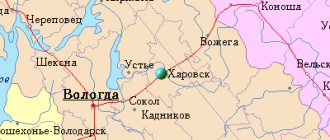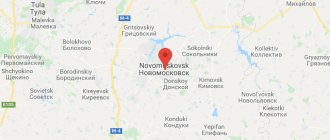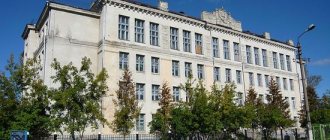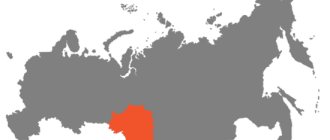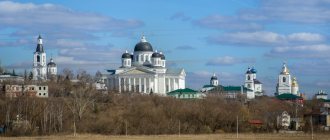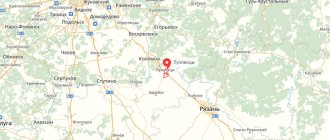Brief historical background
As a settlement, the village of Sasovo was formed in the middle of the 16th century.
The first information about him is contained in the scribe book for the Shatsky district for 1626. The word "Sasovo", according to some scientists, comes from the Tatar "saz" (pronounced "sas"), meaning "swamp", "swampy place". There is another, less convincing version, associated with the legend of a peasant leader named Sasa, who, hiding in swampy places, carried out daring raids on the estates of the boyars.
Since 1778, with the formation of the Ryazan governorship, consisting of three provinces, p. Sasovo was part of the Elatom district of the Tambov province.
From time immemorial, the main occupation of the Sasovites was rope spinning. Rope and rope-resin factories operated. Shipping and trade were also developed. In the 19th century, one of the owners of Sasovo, this already large trading village, was the mother of the great Russian writer I.S. Turgeneva - Varvara Petrovna.
In 1893, passenger and goods traffic opened on the Ryazan-Sasovo section of the Moscow-Kazan Railway. This led to significant economic changes. The population of the village of Sasovo grew rapidly. In 1894, it already had 6,500 inhabitants.
Railway workers from the Sasovo station and local peasants actively participated in the revolutionary events of 1905. A strike committee was created, which clandestinely printed leaflets calling on railway workers and peasants to fight to overthrow the tsarist autocracy.
In December 1917, Soviet power was established in the village of Sasovo. In 1919, M.I. spoke to the railway workers of the Sasovo depot. Kalinin. His arrival was of great importance for strengthening the Soviets and improving the work of the Soviet apparatus. In memory of the stay of M.I. Kalinin in Sasovo, a memorial plaque was installed on the building of the Locomotive Depot.
In 1925, by decision of the All-Russian Central Executive Committee, Sasovo district was formed. On June 19, 1926, the village of Sasovo was transformed into a city, and on October 13, after elections, the city Council of Workers' Deputies began work. Its first chairman was I.N. Kochetkov. About 10 thousand people lived in the city at that time. There was a rope factory, a printing house, a large slaughterhouse, a sewing artel, and a MTS.
There were educational and leisure institutions: three schools, two kindergartens, two libraries, and a railway workers' club.
During the Great Patriotic War, trains with troops, tanks, guns and ammunition traveled along the railway in a continuous stream. The efficient work of the teams at the Sasovo railway station and other departments was noted.
More than 5 thousand Sasovites were awarded military orders and medals, 18 Sasovites were awarded the title of Hero of the Soviet Union. One is a full holder of the Order of Glory. In honor of the Sasovites who died on the fronts of the Great Patriotic War, a memorial complex was opened where the Eternal Flame of Memory burns. On the central street of the city there is a bronze bust of the Hero of the Soviet Union A.S. Mishin.
After the war, new neighborhoods and streets grew in the city. One of the brightest events in the life of the city was the construction of a large automatic line plant, which gave the city a second life. Machine tool products are in demand not only in the domestic market, but also in a number of foreign countries. The Sasovkormash mechanical engineering plant for livestock breeding and feed production is also a large enterprise. In 1962, a commercial equipment plant for the production of commercial equipment for bookstores and general stores - JSC POKO "Sasovotekhmash" - came into operation. In 2004, a plant for the production of alcoholic, non-alcoholic and natural fermented products under the Pershin brand - Eugene Bougele Wine began its production activities, at whose production facilities a new enterprise, Kvasko Bottlers LLC, was created in 2010.
Toponymy
The name of the city, according to some scientists, comes from the Tatar “saz” (“sas”), meaning “swamp”, “swampy place”. Close to this meaning in origin is the name of the main river of the region - Tsna, which goes back to the Finno-Ugric “tsina”, meaning “mud river”. There is another version associated with the legend about the leader of the peasants named Sasa, who, hiding in swampy places, made daring raids on the estates of the boyars.
Geographical names of Slavic origin ending in -ovo, -evo, -ino, -yno are declined. They do not decline only in combination with a generic word: “from the city of Sasovo”, “from the Sasovo region”.
If there is no generic word, then the name is inclined: in Sasov, towards Sasov. The inflected version corresponds to the literary norm and is recommended, for example, for the speech of announcers. Nevertheless, according to modern standards, the inflexible option is also acceptable if it does not hurt the ears.
Status
Municipal entity - the city of Sasovo is an independent municipal entity within the Ryazan region.
The city of Sasovo in its current form was formed in 1926 by the Decree of the Presidium of the All-Russian Central Executive Committee of June 19, 1926 “List of cities of the Ryazan province.” On March 17, 2005, the city was given the status of an urban district by decision of the Sasovo City Duma No. 41 dated March 17, 2005.
The charter of the municipal formation - the urban district of the city of Sasovo was adopted by the decision of the City Duma of March 17, 2005. The new version of the Charter was adopted by the Sasovo City Duma by decision No. 122 of September 19, 2012, and registered with the Office of the Ministry of Justice of the Russian Federation for the Ryazan Region on October 24, 2012. and published in “Information Bulletin” No. 14 dated November 2, 2012.
History of Sasov:
Sasovo was founded in the middle of the 16th century.
The first information about him is contained in the scribe book for the Shatsky district for 1626. The name of the city, according to some scientists, comes from the Tatar “saz” (“sas”), meaning “swamp”, “swampy place”. Close to this meaning in origin is the name of the main river of the region - Tsna, which goes back to the Finno-Ugric “tsina”, meaning “mud river”. There is another version associated with the legend about the leader of the peasants named Sasa, who, hiding in swampy places, made daring raids on the estates of the boyars. Since 1778, Sasovo was part of the Elatom district of the Tambov province. From time immemorial, the main occupation of the Sasovites was rope-spinning. Rope and rope-resin factories operated. Shipping and trade were also developed. In the 19th century, one of the owners of Sasovo, already a large trading village, was the mother of the great Russian writer I. S. Turgenev, Varvara Petrovna. In 1893, passenger and goods traffic opened on the Ryazan-Sasovo section of the Moscow-Kazan Railway. This led to significant economic changes. The population of the village of Sasovo grew rapidly. In 1894, it already had 6,500 inhabitants. Railway workers from the Sasovo station and local peasants actively participated in the revolutionary events of 1905. A strike committee was created, which clandestinely printed leaflets calling on railway workers and peasants to fight to overthrow the tsarist autocracy. In December 1917, Soviet power was established in the village of Sasovo. In 1919, M.I. Kalinin spoke to the railway workers of the Sasovo depot. His arrival was of great importance for strengthening the Soviets and improving the work of the Soviet apparatus. In memory of M.I. Kalinin’s stay in Sasovo, a memorial plaque was installed on the building of the Locomotive Depot. In 1923, the Elatomsky district of the Tambov province became part of the Ryazan province (since September 26, 1937 - the Ryazan region). In 1925, by decision of the All-Russian Central Executive Committee, Sasovo district was formed. On June 19, 1926, the village of Sasovo was transformed into a city, and on October 13, after elections, the city Council of Workers' Deputies began work. Its first chairman was I.N. Kochetkov. About 10 thousand people lived in the city at that time. There was a rope factory, a printing house, a large slaughterhouse, a sewing artel, and a MTS. There were educational and leisure institutions: three schools, two kindergartens, two libraries, and a railway workers' club. During the Great Patriotic War, trains with troops, tanks, guns, and ammunition traveled along the railway in a continuous stream. More than 35 thousand residents of the Sasovsky district were drafted to the fronts of the Great Patriotic War, of which more than 10 thousand died, more than 5 thousand Sasov residents were awarded military orders and medals, 18 Sasov residents were awarded the title of Hero of the Soviet Union. One is a full holder of the Order of Glory. In honor of the Sasovites who died on the fronts of the Great Patriotic War, a memorial complex was opened where the Eternal Flame of Memory burns. On the central street of the city there is a bronze bust of the Hero of the Soviet Union A.S. Mishin. After the war, new neighborhoods and streets grew in the city. One of the brightest events in the life of the city was the construction of a large automatic line plant, which gave the city a second life. Today the city is the administrative center of the Sasovsky district.
History of the coat of arms
The coat of arms of the city of Sasovo was approved at a meeting of the Sasovo City Duma by decision No. 41 dated December 25, 1997 and registered in the State Heraldry, registration number 328.
Description of the coat of arms: in a dissected silver and green shield on the right there is an azure (blue, light blue) wavy baldric, on the left there are two silver left narrow baldrics; in the heart of the shield there is a golden bundle of rope placed in the belt; in the scarlet (red) chapter there is a tower crown with three teeth, lined with silver and burdened on a hoop with three gold bezants (coins). In the golden free part with a rounded corner there is an old green princely hat with a black sable edge, above which there is a gold decoration (“town”) with a scarlet semi-precious stone.
From the history of the coat of arms of the city of Sasovo: The coats of arms of the city of Sasovo and the Sasovo region can be called siblings and almost twins, since they appeared almost simultaneously, are largely based on common symbols and have the same construction system. This principle was deliberately chosen from the very beginning of work on the coats of arms so that at the first glance at them their relationship would be evident and their connection with the Sasovo land would be remembered. After all, although each coat of arms symbolizes an independent subject of law (city and region), both of them designate a common territory that has a common history, nature and traditions.
Each coat of arms is a dissected (vertically divided in half) heraldic shield with a “head” - a special honorary heraldic figure occupying the upper third of the shield. As far as we can judge today, no other modern municipal coat of arms in Russia has this form of construction. Everything related to the general history of the city and region is depicted at the bottom of both armorial shields.
As is known, until 1923 these lands were part of the Elatomsky district of the Tambov province, then the district was annexed to the Ryazan province, and in 1925 an independent Sasovo district was formed within it, with its center in the village. Sasovo. Since ancient times, the main trade and transport route here has been the Tsna River. According to it, in time immemorial, these lands were settled by the Vyatichi Slavs.
A symbolic image of the river is placed on the right (left of the viewer) silver part of both coats of arms in the form of a lazarus (blue, light blue) wavy band (diagonal stripe). At the end of the 19th century, the Moscow-Kazan Railway passed through these lands, which became a new trade and transport artery. Thanks to her, the economic development of the entire region was revived, in the village. A large railway depot was created in Sasovo, which further served to transform it into an industrial city.
The steel mainline of symbolism is depicted in the left (to the viewer's right) green part of the coats of arms in the form of two narrow silver belts. An azure and two silver baldrics are connected at the base of the coat of arms in the shape of the Latin letter “V”, which is the original letter “viktori” (victory). The combination of symbolic images of water and steel transport routes at the base of the coats of arms can be interpreted as a sign of their fundamental significance and continuity in the development of the Sasovo region. And then the differences begin. In the old days, the village of Sasovo was famous for its rope and rope spinning production. Merchants from all over central Russia came to the annual fairs to buy the products of Sasovo craftsmen. Sasovo ropes and ropes also went outside the country. Sailing ships were equipped with them. At the end of the 18th century. this gave Catherine II the basis to equip the silver sail in the coat of arms of the county town of Elatma with gold “Sasovo” ropes, which thus appropriated part of the glory of Sasovo craftsmen.
In the modern coat of arms of the city of Sasovo, in the center of the shield there is an image of a bunch of golden rope in the shape of an infinity sign, intercepted in the middle by a golden rope, as a reminder of where the glory began and the industrial development of the city began. In the coat of arms of the Sasovo region, in the heart of the shield there is a golden sheaf of grain tied with the same gold rope with a forked top, placed in a pillar (vertically). In heraldry, a sheaf of grain traditionally symbolizes agriculture, grain production and the fertility of the land - what is the basis of the economy of the region. And its bifurcated top, looking as if to the past and future, suggests that agriculture was, is and will be the basis of the region’s well-being at all times.
The most significant differences concern the “heads” of the two coats of arms. The coat of arms of Sasovo has a scarlet (red) “head”, in which there is an image of a silver tower crown with three teeth. Such crowns have been used since the middle of the 19th century. coats of arms of district cities were decorated. The crown was placed above the shield, so s. Sasovo, after it acquired the status of a county town in 1926, could, according to Russian heraldic tradition, receive a coat of arms with a silver city crown. But in Soviet times this did not happen, and currently Sasovo is not a district town, but a municipal entity. Therefore, the crown is depicted directly in the coat of arms. Three gold coins (“bezants”) are placed around its hoop, indicating that from time immemorial there was a rich trade in Sasovo, thanks to which it grew and developed. And the scarlet (red) background reminds us that two years after Sasovo acquired the status of a city, in May 1928, almost half of the city’s territory was destroyed by a huge fire, and much had to be rebuilt. The reflection of this fire speaks of the grief and glory of the inhabitants who survived this misfortune and built a modern city.
The coat of arms of the municipal formation - Sasovo district has an azure (blue, light blue) “head”, in which there is an image of a silver flying heron. It takes us back to the very name of the region and the city, which, according to most researchers, goes back to the Turkic root “sas” (“soz”, “sasy”), which means “swamp, swampy place”. Close to this meaning in origin is the name of the main river of the region - Tsna, which goes back to the Finno-Ugric “tsina”, meaning “mud river”. In addition to Tsna, there are many other rivers, lakes and swamps in the area.
One of the most characteristic inhabitants of such places is the heron. In heraldry, it, along with the crane, symbolizes vigilance, caution and fearfulness and therefore can serve as an emblem of the untouchedness, pristineness of these places, their ecological purity and reserve. This allows the image of a bird to be interpreted as a symbol of love and affection for one’s native land. And the heron flying in the coat of arms of the Sasovo region over the golden loaves, the azure river and the silver highway seems to be looking at its region, its nature and history - past, present and future - from heavenly heights.
Story
The city was founded in the middle of the 16th century. The first information about him is contained in the scribe book for the Shatsky district for 1626. Since 1778, Sasovo has been part of the Elatom district of the Tambov province.
From time immemorial, the main occupation of the Sasovites was rope-spinning. Rope and rope-resin factories operated. Shipping and trade were also developed. In the 19th century, one of the owners of the large trading village of Sasovo was the mother of the great Russian writer I. S. Turgenev - Varvara Petrovna.
In 1893, passenger and goods traffic opened on the Ryazan-Sasovo section of the Moscow-Kazan Railway. This led to significant economic development in the village. In 1894, 6,500 inhabitants lived in Sasovo.
Railway workers from the Sasovo station and local peasants actively participated in the revolutionary events of 1905. A strike committee was created, which clandestinely printed leaflets calling on railway workers and peasants to fight to overthrow the tsarist autocracy.
Administrative division
The total area of the municipality - the urban district of Sasovo is 24.04 square meters. km, including:
— industrial land — 238 hectares;
— public land — 323 hectares;
— forest areas — 105 hectares;
— agricultural land — 656 hectares;
- lands occupied by water - 123 hectares;
— land for transport, communications and utilities — 130 hectares;
— residential land — 254 hectares;
— land for public and business development — 171 hectares;
— under military and other sensitive facilities — 32 hectares;
- not involved in urban planning or other activities - 372 hectares.
Transport
The city of Sasovo is provided with three intercity (Kadom, Ermish, Ryazan) and one interregional bus route Sasovo - Kadom - Moscow.
There are 4 local ring routes with opposite traffic and 5 city routes serving the inner part of the residential zone and the industrial zone.
The maximum distance in the city from the nearest bus stop is 500 m.
A railway line passes through the city, along which freight and passenger transportation is carried out from Moscow in an easterly direction to the Urals and Siberia.
Sasovo
origin of name
According to some scientists, the name of the city could come from the Tatar word “sas” (or “saz”), which means “swampy place”, “swamp”. The main river of the region, Tsna, also has a similar meaning. Presumably, the name of the river comes from the Finno-Ugric word “tzina” (mud river). We can conclude that different peoples, being in this territory, left place names indicating the marshy area. There is a version that the name of the city is associated with the leader of the peasants named Sasa. The leader hid from the authorities in local forests and periodically made daring raids on rich estates.
Village of Sasovo
According to scientists, the history of Sasovo began in the 16th century. A record of the emergence of a new settlement was found in the book of Shatsky district. However, there is practically no information about how the city (originally a village) arose and how it developed. Traditionally, the residents of Sasovo made their living by rope-spinning craft. Over time, enterprises of the same type appeared in the village. On the territory of the village, 2 factories were organized - a rope plant and a rope-resin plant. Shipping and trade actively developed in Sasovo due to the presence of a navigable river. To sell the products of Sasovo craftsmen, fairs were held annually in the village, which attracted buyers from the most remote corners of Russia. Sasovo ropes and ropes were in great demand even abroad. Sasovo products were purchased to equip sailing ships. It is known that even Catherine II bought ropes in Sasovo for the silver sail placed on the coat of arms of Elatma (county town). The Empress's interest in Sasovo products attracted even more attention to the village's products.
In the 18th century, the village of Sasovo became part of the Tambov province. By the beginning of the 19th century, the village became one of the largest shopping centers in the province. According to the List of populated places of the Tambov province for 1866, Sasovo is a proprietary village of the Elatom district near the Sasovka river, 78 versts from the district town of Ela. There were 622 households in the village, in which there were 5,890 residents of both sexes - 2,941 males and 2,949 females. In Sasovo there were 2 churches, a fair, and a bazaar.
At the end of the 19th century, Sasovo was owned by the mother of the great Russian writer I. S. Turgenev - V. P. Turgenev. One of the significant events of the late 19th century was the appearance in 1893 of a railway line not far from the village, connecting Moscow and Kazan. On the section between Sasovo and Ryazan, goods and passenger traffic was opened, which had a beneficial effect on the economy of the village. The population of Sasovo begins to grow rapidly. Just a year later, in 1894, more than six thousand people already lived in the settlement.
Residents of Sasovo, as well as workers of the local railway station, became active participants in the revolutionary events of 1905. A strike committee appeared in the village, printing and distributing leaflets calling for a fight against the autocracy. In 1917, Soviet power came to the village. In 1919, M.I. Kalinin spoke to Sasovo railway workers. The purpose of his visit was to strengthen Soviet power in the village. In memory of the fact that a distinguished guest visited the village of Sasovo, a memorial plaque was installed on the facade of the local locomotive depot building.
City of Sasovo
In 1923, the village of Sasovo was part of the Elatom district and became part of the Ryazan province. In 1925, Sasovsky district was created, and on June 19, 1926, the village received city status. Elections took place in mid-October of the same year. The Council of Workers' Deputies began its work in the city, the first chairman of which was I.N. Kochetkov. By that time, about ten thousand people lived in Sasovo. In addition to factories, there were MTS, a slaughterhouse, a sewing artel and a printing house operating in the city. In addition, in Sasovo there were 2 kindergartens, 3 schools, 2 libraries and a railway workers' club.
The Great Patriotic War
During the Great Patriotic War, trains with tanks, troops and ammunition passed through Sasovo. The work of Sasovo railway workers during these difficult years for the country was marked by particular coherence and clarity. More than 35 thousand soldiers went to the front from the Sasovo region. Almost a third of those mobilized (about ten thousand) did not return home. 5 thousand soldiers were awarded military medals and orders. 18 Sasovites were awarded the honorary title of Hero of the Soviet Union. Among the recipients was even awarded the title of full holder of the Order of Glory. After the end of the Great Patriotic War, a memorial complex was opened in memory of the fallen Sasovites. The Eternal Flame is constantly burning on the territory of the complex. A bronze monument was erected to one of those awarded the title of Hero of the Soviet Union - A. S. Mishin - on the central street of the city.
Post-war years
With the advent of peacetime, the construction of new streets and neighborhoods began in the city. One of the most important events in post-war Sasovo was the construction of an enterprise for the production of automatic lines. Largely thanks to this plant, a new stage of economic development began in the city. Over time, several more industrial enterprises opened in the city. The automatic line plant was transformed in 1994 by SASTA OJSC. Despite economic crises and constant changes of owners, the plant continues to operate today, providing city residents with jobs and stable income. The products of the SASTA OJSC enterprise are in demand not only in Russia, but also beyond its borders.
Another large enterprise in Sasovo is the Sasovkormash mechanical engineering plant for livestock farming and feed production. In the early 60s, a plant for the production of commercial equipment for bookstores and mixed stores was commissioned - JSC POKO "Sasovotekhmash". In the 2000s, a new enterprise appeared in Sasovo - a plant for the production of alcoholic, non-alcoholic and natural fermentation products "Pershin" - "Eugene Bujelet Wine". In 2010, the production facilities of this enterprise were created.
Communications, media
There are three automatic telephone exchanges in the city with a total capacity of 8248 numbers, which have access to an international connection and the INTERNET computer network.
The city of Sasovo has its own cable television studio, which provides residents with 27 television channels.
Since 2010, the city has been able to connect residents to digital television, which has more than 80 channels.
In the municipality of Sasovo, two socio-political newspapers are published: “Call from Sasovo”, “Sasovo Week”.
Culture, education, social life
In the city there are 8 pre-school educational institutions, 5 general education schools, 5 additional education institutions (Center for the Development of Creativity of Children and Youth, Young Technicians Station, Municipal Budgetary Educational Institution of Educational Institutions FSK "Crystal", music and art schools), evening correspondence classes at secondary school No. 6, center for social and psychological assistance to children and adolescents, information and methodological center.
On the territory of the city of Sasovo is located the State Educational Institution of Secondary Professional Education Sasovo Industrial Technical School, which combines agricultural and technological technical schools, 2 branches of Moscow universities based on technical schools, 1 branch of the Radio Academy, Sasovo Flight School of Civil Aviation.
The city has 1 Sasovo centralized library system, which includes 5 branches of city libraries.
The local history museum of Sasovo is widely known, which conducts large excursion activities. Information about it is available in the All-Russian Register of Museums, and the Tourism website reports on the sights of the city of Sasovo - the Kazan Church (built in 1815). Churches in honor of the Archangel Michael (built in the 90s of the twentieth century) and in honor of the Nativity of the Blessed Virgin Mary (built in 2010); merchant houses of the 19th century (the building of the local history museum, school No. 106, the military registration and enlistment office, the city administration) and monuments located on the territory of the city.
The history of the youngest institution - the Museum of Russian Song named after A.P. Averkin has been underway since 2000. Unique exhibits – personal belongings of A.P. Averkin, artists L. Zykina, A. Strelchenko, A. Litvinenko, V. Tolkunova, rare musical instruments attract the attention of city guests.
The city's fellow countrymen are the Russian philosopher and cosmist N.F. Fedorov, actor and director A.P. Lensky, writer Yu.M. Korolkov.
The name of Nikolai Fedorovich Makarov, a native of the village. Sasovo, the creator of the world-famous PM pistol, AM-23 aircraft cannon and other types of weapons, will forever go down in the history of Russian defense technology and industry. The first model of small arms developed by Nikolai Fedorovich - a 9-mm pistol, on which he worked for more than five years, in conditions of fierce competition from the authors of other projects, successfully passed tests and was adopted by the Soviet Army in 1951. Until now, for more than half a century, it has been the personal weapon of army officers, employees of the Ministry of Internal Affairs and other law enforcement agencies of our country. Mass production of Makarov pistols was established not only in the USSR, but also under appropriate licenses abroad. The number of Makarov pistols “released” is in the millions. For a long time, “PM” had no analogues in its class in terms of weight and dimensions, simplicity of design, originality of the trigger mechanism and manufacturability.
At the end of 2012, the Sasovo municipal formation took first place in the nomination for the title “The most comfortable urban district, urban settlement of the Ryazan region,” with a bonus paid to the city in the amount of 1,500 thousand rubles.
The terrible curse of Sasovo
For avid Internet users, Sasovo is a once popular cartoon. For ufologists - UFO airfield. And for local authorities it is a hotbed of freethinking.
For the second year in a row, residents of the Sasovsky district of the Ryazan region write letters to the presidents of the country - first Putin, then Medvedev, demanding to stop the illegal construction of a chemical plant. Rural school teachers who created an environmental organization gather so many people for protests that Moscow and St. Petersburg “dissenters” envy them. And for direct communication with Vladimir Putin, Sasovo environmentalists prepared their own flash mob: several dozen people called the community center throughout the day and asked the same question: “Why is the Constitution of the Russian Federation not being respected in the Ryazan region?”
Stranglehold
The protest movement is headed by a former teacher, disabled person of the second group, Vera Mikhailovna Dronnik from the village of Sotnitsyno. From here to Moscow is 400 versts, to the regional center of Sasovo - 15. A terrible disease - cancer - has a stranglehold on the village. Vera Mikhailovna leafed through the notebook with which she walked around the courtyards, writing down sick fellow villagers. The results are shocking - 40 cancer patients.
“On Gagarin Street alone, out of 58 people, seven fell ill over the past two years. Four have already died
, says Dronnik.
The pensioner took up the terrible statistics after the death of 12-year-old Masha Tatyanina. At the beginning of 2007, doctors gave the girl a terrible diagnosis - blood cancer. The story is generally common in Russia: Masha needed urgent surgery, and her parents did not have money for treatment. The girl’s father, Dmitry, received about 5 thousand rubles at the sugar factory in Sotnitsyno. His wife Marina, head of the library, and even less so. Treatment at the Ryazan OKB was free only on paper.
“We were forced to buy everything ourselves, from syringes to medicines, which cost tens of thousands of rubles,” says Dmitry. “In order to somehow get out, they started calling relatives and friends. Neighbor Vera Mikhailovna was one of the first to respond to the call for help.
At first, she took her pension to Tatyanin. Then, she went to the Sasovo church with a photo of the girl and collected another 10 thousand rubles. The entire village then began donating money for treatment. But it was not possible to save the girl. After the funeral, the villagers seriously thought about the reasons for the high mortality rate in the village.
Poisoned life
Two enterprises came under suspicion.
The first is the yeast workshop. No cleaning. The waste is simply dumped into ditches. The fumes, along with the pores of the fungi, are carried by the wind.
The second is the Maltsevsky chemical plant, five kilometers away, dumping waste into the Aleshnya River.
“We began to correspond with Moscow experts, with biological and chemical institutes, with professors at Moscow State University,” says Sotnitsino resident Tatyana Indeeva, “and found out that such disposal of yeast waste is similar to the explosion of a bacteriological bomb. The pores of the fungus inside the body do not die, but develop, causing malignant tumors. And although the local state epidemiological surveillance reassured us, they say, everything is fine - no big deal, the owners of the yeast workshop, after repeated complaints, agreed to install cleaning equipment.
With the second enterprise everything turned out to be more complicated. Rural ecologists found out that the owners of the chemical plant, without approvals or examinations, decided to launch a phenol-formaldehyde resin workshop.
“Phenol is a potent poison,” says Tatyana, “causing poisoning of the body, including through the skin. A quarter of the body's surface area is fatal. But construction proceeded without a project, anyhow. Look...
She pulls out documents according to which the construction of a workshop for the production of phenol-formaldehyde resins began in 2006, and the working draft was sent for examination only in 2007. He received a negative conclusion. But this fact was ignored.
The worst thing, the villagers believe, is that the largest elevator in the Ryazan region operates in close proximity to chemical production, and in total, six villages with a population of more than 5,000 people fell into the exclusion zone. Naturally, no one is going to resettle them.
Trouble united
Vera Dronnik realized that it was difficult to achieve anything alone and published in the regional newspaper an appeal to her fellow countrymen to unite to fight the chemists. The note had the effect of a bomb exploding. Residents of villages and even the regional center began to join the rural environmental organization.
...Entrepreneur Tatiana Kuzina has her own store, house, and jeep. 32-year-old worker Oleg Ulyantsev drives around Sasovo in an old Lada. Social statuses are different, the problem is the same. A year ago, Tatyana’s mother died of cancer. Oleg's father is sick.
“We have our own house not far from Sotnitsyno, in Sablino, maybe my father caught this infection there, he really loved to tinker in the garden,” Oleg wonders, and Father Lukashenko frowns sternly from the portrait on the wall in his apartment.
After the collapse of the Union, Ulyantsev’s father remained to serve in the Belarusian army, and when he retired in 1997, the family returned to their homeland in Sasovo. And now - cancer.
“I can’t understand one thing,” Oleg continues, “Putin seems to be cooler than Lukashenko.” But then the dad said, and all the officials immediately rushed to do it. But here it’s the other way around. On TV it’s one thing, but in life it’s another. And I don't want it to be like that. My son is growing up. So I thought, maybe I can change something.
Tatyana called after Vera’s note and offered help.
And teachers from Lyubovnikovskaya secondary school who joined the organization proposed holding a referendum.
Refugees are tough nuts to crack
Residents of Lyubovnikovo are lucky - the chemical plant is twenty kilometers away, and people here get sick much less often. It seems that what do they care about other people's troubles?
But refugees from the former republics of the USSR settled here, having survived the parade of sovereignties of the 90s. Using them, you can study the geography of interethnic conflicts on the territory of the former Soviet Union. Ekaterina Harutyunyan, a philologist, fled from Turkmenistan, her husband, historian Arthur, from Kyrgyzstan. Librarian Natalya Bakanova was evacuated by a military transport plane from Baku. The school director, Saligzhan Zaripov, moved to Russia from Uzbekistan. They all started here from scratch, they know what a pound is worth, and they could not stay away.
“When you begin to understand that the nightmare can repeat itself, it becomes scary,” says Harutyunyan, deputy chairman of the movement. - It doesn’t matter what you’re running from, from nationalists, or from toxic emissions. That's why we set out to organize a referendum.
The law, alas, is no help to them
It was very difficult to get through the legislative fence. The election commission, having considered the application, forwarded it to the district duma, which twice prohibited the referendum. The only one of the people’s representatives who voted “for” was the doctor at the local hospital from the village of Demushkino, Yuri Ignatov, a former “Afghan”. Like Lyubovnikov’s teachers, he himself is a forced migrant. He arrived in 1992 with his wife and nine children (six of whom were adopted) from Bendery. According to Yuri, he did not believe in a positive outcome of the vote, but when the deputies began to count whether chemists would have any benefit, the scales swung in the opposite direction.
“This may be cynical, but in our time money decides a lot,” he says, “but it turned out that the chemical plant does not pay taxes, since it is generally registered in the Nizhny Novgorod region. The lands of three of our farms are suffering from it. The chairmen of these farms also became worried - the “chemists” began to buy up land shares. In general, the deputies thought and voted “for”.
The referendum was held on March 2 simultaneously with the presidential elections. 92 percent of Sasovo residents answered the question: “Do you consider it necessary to locate the production of phenol-formaldehyde resins in the region?” - they answered negatively.
What is God's dew
But... But the owners of the chemical plant continued construction. Then mass rallies began in the Sasovo region. In parallel with the street protests, there was a battle in court. And in the end, environmentalists won the dispute, and a court order was issued to ban construction. The workshop was sealed by bailiffs.
“A month ago, the bailiffs informed us that their seals had been broken, and the installation of equipment began in the workshop. We don’t have the right to go inside, because the plant is private property,” Vera Dronnik complains. “Therefore, protests will continue.
The head of the district, Alexey Anokhin, supports environmentalists.
“There will be no workshop in my district,” he says.
However, residents are confident that decisions are made at a different level.
“In our time, not a single entrepreneur would risk building a new plant without enlisting the support of the provincial authorities,” says Vera Mikhailovna, “but it was the provincial authorities who created a special interdepartmental commission, which should deal with resolving this issue.” They are lying, of course...
The Sasovites cannot understand what kind of “settlement” they are talking about when there is a court ruling and the results of the referendum. However, in Russia, the “legal fields” between the authorities and the people are very different.
The Free Press will follow developments.
From our dossier
The owner of the workshop is a certain LLC “Novoye” of the Nizhnemaltsevsky chemical plant, registered in Dzerzhinsk, Nizhny Novgorod region. General Director of the plant Ravil Nafikov. At first, management passed off the structure being built as either a locomotive hangar or a warehouse. After the referendum, they tried to challenge its results in the Arbitration Court of the Ryazan Region, proving the illegality of the popular vote, which affected the economic interests of the enterprise. The court confirmed the legality of the actions of the region's population. The production was designed by the St. Petersburg enterprise Safe Technologies.
